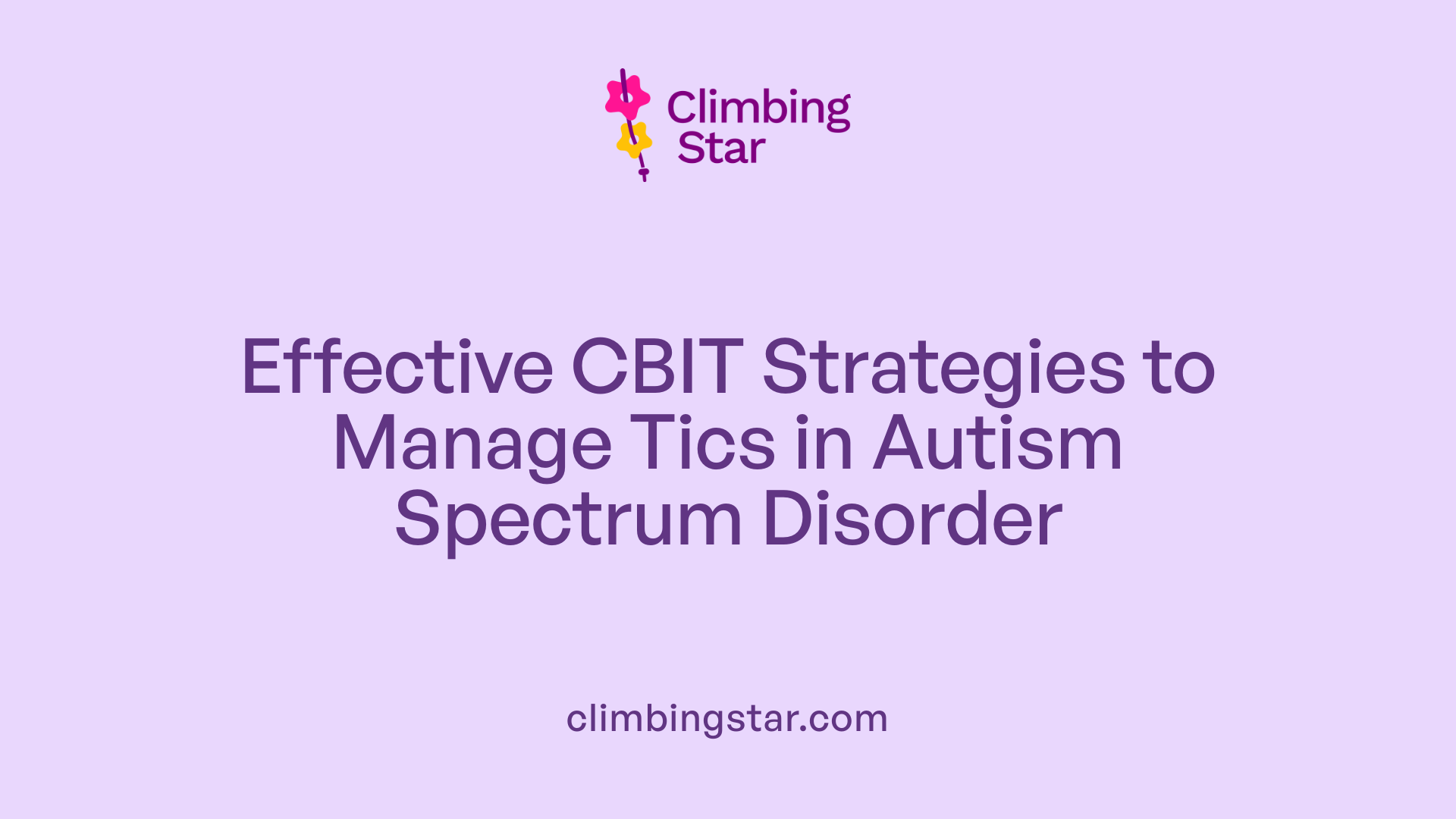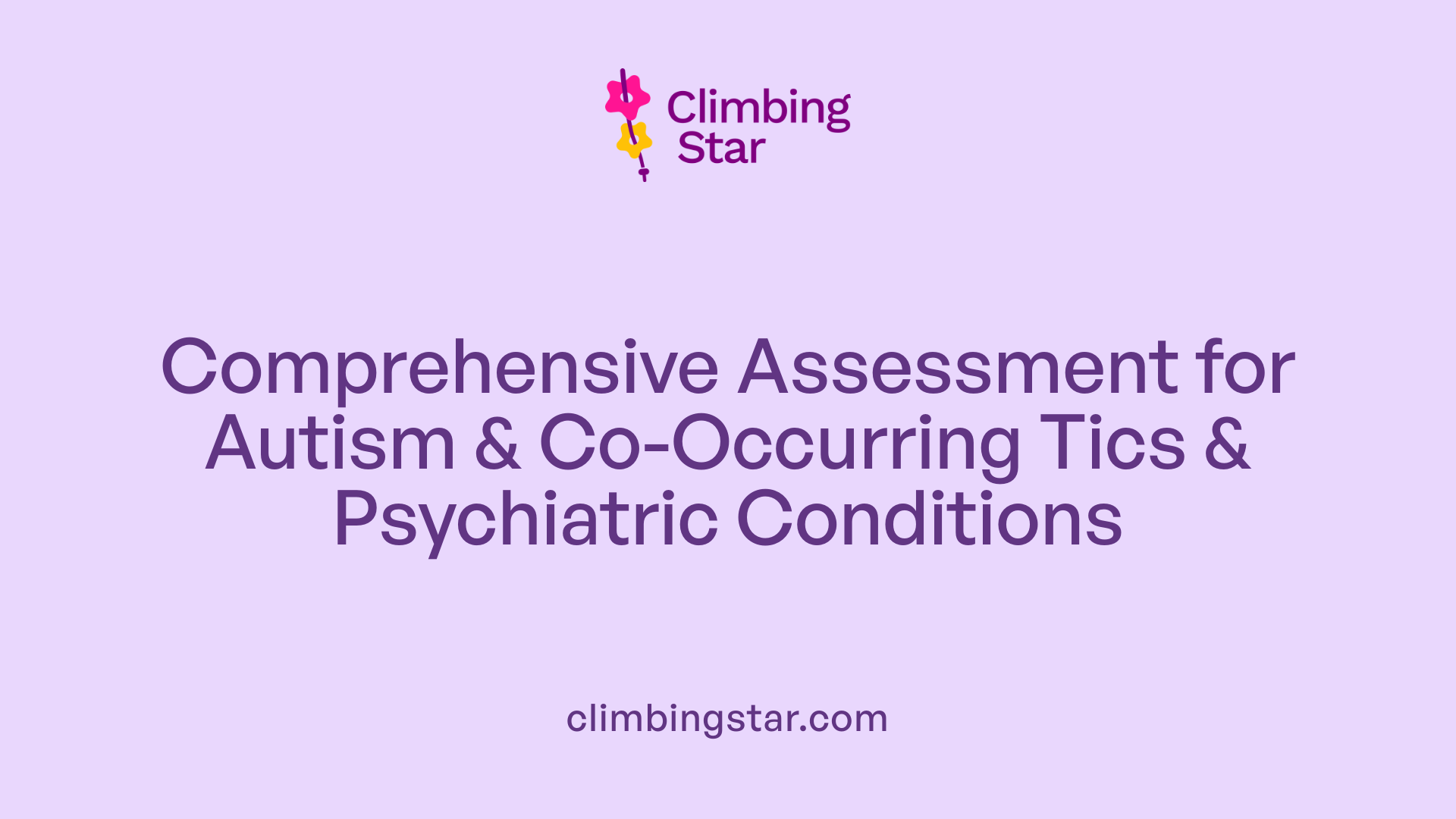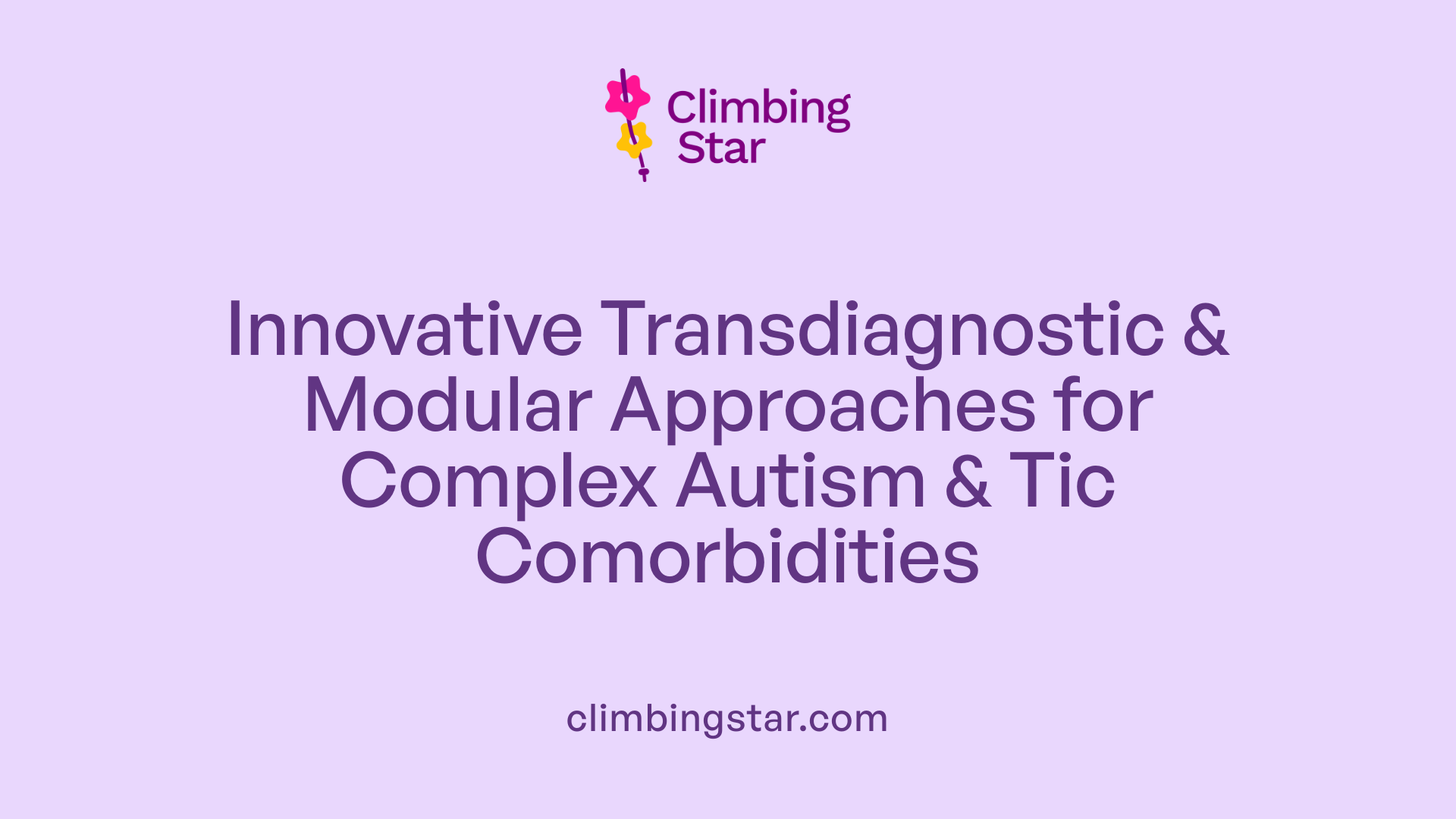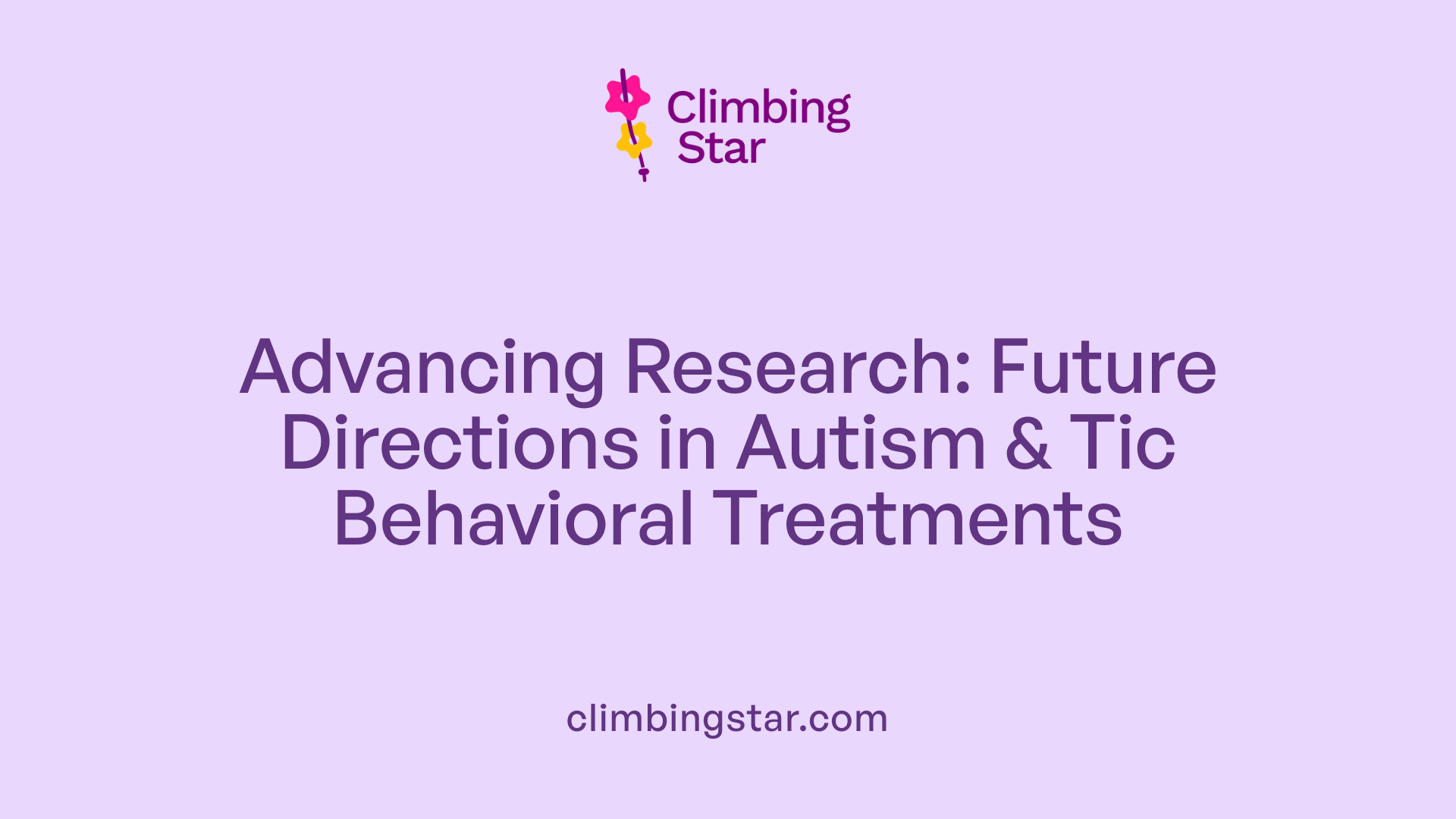Understanding the Intersection of Autism and Tic Disorders
Autism spectrum disorder (ASD) and tic disorders often coexist, presenting unique challenges for therapeutic interventions. Behavioral therapies, particularly those rooted in applied behavioral analysis (ABA), have demonstrated efficacy in addressing the core symptoms of autism while also offering promising strategies for managing tic behaviors. This article explores how established and emerging behavioral interventions can be employed to support individuals navigating both autism and tics, highlighting comprehensive treatment models, tailored approaches, and the integration of comorbidity management.
Applied Behavior Analysis (ABA) Therapy: Foundations and Benefits for Autism
What is Applied Behavior Analysis (ABA) therapy, and how does it benefit individuals with autism?
Applied Behavior Analysis (ABA) therapy is a science-based method focused on understanding and modifying behaviors through environmental adjustments. It helps individuals with autism improve their communication, social skills, and daily living abilities, while reducing problematic behaviors. ABA utilizes positive reinforcement to encourage desirable behaviors by rewarding them, alongside analyzing the triggers and consequences of behaviors to shape them effectively. Programs are customized to meet each individual's needs, and progress is regularly tracked to adjust strategies as needed. Research indicates that early, intensive ABA can significantly boost developmental growth and social communication skills in children with autism.
What types of behavioral goals are commonly addressed in ABA therapy for autism?
ABA therapy targets a range of behavioral goals centered on skill-building and behavior reduction. It aims to enhance communication, language, social interaction, academic skills, and self-care abilities. Simultaneously, it works to reduce harmful or disruptive behaviors such as aggression, self-injury, tantrums, or non-compliance. Goals are customized to be specific and measurable, focusing on increasing independence and everyday functioning. The therapy also stresses applying learned skills across various environments and maintaining improvements over time. Continuous data collection and collaboration among therapists, families, and educators help refine these objectives to align with the individual's evolving needs.
How is the effectiveness of ABA therapy measured for individuals with autism?
Effectiveness is measured through systematic data collection of observable behaviors defined clearly for tracking progress. Therapists record metrics like frequency, duration, or intensity of target behaviors such as social interactions or communication attempts. Assessments are done before, during, and after interventions to evaluate improvements. Graphs and charts visually present behavioral trends, helping families and practitioners understand changes over time. Statistical analyses may be used to determine if observed gains are significant. Successful outcomes usually include improved language, social skills, and adaptive behaviors that reflect the personalized intervention goals.
What is the recommended age range for starting ABA therapy in individuals with autism?
ABA therapy is most beneficial when started early, ideally between ages 2 and 6, during key developmental stages. Some models even commence therapy as young as 6 months. Early intervention maximizes gains in communication and social skills. Nevertheless, ABA is flexible and effective regardless of age, supporting adolescents and adults with autism as well. There is no upper age limit for starting ABA, and therapies are adapted to suit older individuals’ unique needs. Early diagnosis and prompt therapy initiation generally yield the best long-term outcomes, but benefits can be achieved at any stage of life.
How is ABA therapy personalized and monitored?
ABA therapy programs are tailored to the individual's profile, focusing on their strengths, challenges, and preferences. Therapists conduct thorough assessments to design interventions that fit each person’s developmental level and goals. Sessions involve repeated data collection and ongoing evaluation to ensure that the intervention remains effective and relevant. Adjustments are made based on progress, with input from families and other caregivers to maintain consistency across home, school, and community environments. This personalized approach helps optimize behavioral improvements and generalization of skills.
Who Provides ABA Therapy for Individuals with Autism?

Qualifications and Roles of ABA Providers
ABA therapy for individuals with autism is delivered by professionals trained specifically in behavioral analysis and autism interventions. Among the most recognized are Board Certified Behavior Analysts (BCBAs), who have advanced certification confirming their expertise in ABA. These specialists often lead the development and oversight of individualized treatment plans.
Supporting them are licensed therapists and behavior technicians who carry out the day-to-day therapy sessions under BCBA supervision. These roles ensure that the therapy is tailored and adapted to the evolving needs of each individual with autism.
Settings Where ABA Therapy is Delivered
ABA therapy is highly adaptable and is provided across various settings. Common locations include specialized clinics designed for behavioral interventions, the individual's home for more naturalistic application, and educational environments such as schools to integrate learning.
These diverse settings enable therapists to target social, communication, and behavioral challenges in contexts relevant to the individual's daily life, thereby improving effectiveness and generalization of skills.
Support for Families and Caregivers
An important component of ABA therapy is the involvement and training of families and caregivers. Providers often offer guidance and coaching to empower them with strategies for managing behaviors and reinforcing progress beyond formal sessions.
This support helps maintain consistency and fosters an environment conducive to continued improvement, extending the benefits of therapy into everyday interactions.
| Provider Role | Description | Typical Setting |
|---|---|---|
| Board Certified Behavior Analyst (BCBA) | Oversees treatment plans and supervises therapy delivery | Clinics, Schools, Homes |
| Licensed Therapist | Conducts therapy sessions focusing on behavioral interventions | Clinics, Homes, Schools |
| Behavior Technician | Implements daily therapy activities under supervision | Homes, Clinics |
ABA therapy providers form a collaborative network focused on delivering personalized and effective care tailored to the unique needs of individuals with autism.
Behavioral Approaches to Managing Tic Disorders in Autism
What Are Tic Disorders and Their Relevance in Autism?
Tic disorders involve sudden, rapid, and repetitive movements or vocalizations. Individuals with autism spectrum disorder (ASD) frequently experience co-occurring tic disorders, which can compound social and behavioral challenges. Managing these tics effectively is vital to improving overall quality of life for people with autism.
What Behavioral Therapy Options Exist for Tic Disorders?
Behavioral interventions are the frontline therapies for tic management in autism. Common approaches include:
- Comprehensive Behavioral Intervention for Tics (CBIT): An 8–10 week structured program enhancing tic awareness and encouraging competing responses.
- Habit Reversal Therapy (HRT): Focuses on training individuals to recognize tics and develop alternative behaviors.
- Exposure and Response Prevention (ERP): Aims to reduce tic severity by gradually exposing individuals to premonitory urges and preventing the tic response.
- Facotik Therapy: A manualized intervention for children, addressing cognitive and physiological processes underlying tics.
These therapies often incorporate psychoeducation, parental training, and self-monitoring to support sustained improvements.
How Do CBIT and HRT Function in Tic Management?
CBIT and HRT have strong scientific backing as effective, evidence-based treatments. They operate by:
- Increasing awareness of premonitory urges that precede tics.
- Teaching competing responses that interrupt the tic behavior.
- Incorporating behavioral restructuring techniques to modify daily routines and emotional triggers.
Studies show that over 50% of children undergoing CBIT experience significant reductions in tic severity, though these therapies are not cures but symptom management methods.
What Role Does Behavior Modification Play in Managing Tics?
Behavioral therapy aims to alter the cycle of tic urges and responses. By heightening self-monitoring and providing tools to replace tics with less disruptive behaviors, individuals learn control over tic expression. Emotional regulation and routine modifications complement these techniques, addressing triggers common in autism.
This tailored, structured approach aligns well with autism behavior therapies like applied behavior analysis (ABA), offering integrated treatment pathways for individuals facing both autism and tic challenges.
Comprehensive Behavioral Intervention for Tics (CBIT): Methods and Outcomes

Structure and Duration of CBIT
CBIT is an 8-10 week behavioral therapy program primarily designed to help manage tics, including those associated with conditions such as Tourette Syndrome and autism spectrum disorder (ASD). It is typically administered by occupational therapists through weekly sessions that provide structured and personalized interventions.
Key Components: Awareness Training, Competing Responses, Routine Modification
The therapy focuses on several essential elements. First, awareness training helps individuals recognize their tics and the urges that precede them. This heightened self-awareness is crucial for managing tics effectively.
Next, development of competing responses involves teaching patients to perform alternative, less disruptive behaviors when they feel the urge to tic. These competing behaviors help disrupt the tic cycle.
Finally, routine modification includes adjustments to daily activities and environments to minimize triggers and reduce tic frequency and severity. This holistic approach equips individuals with practical skills to manage tics effectively in real-life situations.
Efficacy Data and NIH Research Findings
Research from the National Institute of Health (NIH) shows that over 50% of children undergoing CBIT experience significant reductions in tic severity. Although CBIT is not a cure for tic disorders, it empowers individuals to manage symptoms effectively, leading to improved quality of life.
Application of CBIT for Individuals with Autism and Tics
CBIT is especially relevant for individuals with autism who also experience tics, as it aligns with behavioral analysis approaches commonly used in autism treatments. CBIT’s structured and rule-based framework complements autism therapies by enhancing self-monitoring and emotional regulation.
This synergy offers promising outcomes in treating co-occurring tics in autism, as awareness and competing response training address both tic behavior and associated executive function challenges. Overall, CBIT can be a vital part of integrated care plans for individuals with ASD and tics, supporting symptom reduction and improved daily functioning.
Habit Reversal Training (HRT) and Exposure and Response Prevention (ERP) in Tic Management
What are Habit Reversal Training (HRT) and Exposure and Response Prevention (ERP)?
Habit Reversal Training (HRT) and Exposure and Response Prevention (ERP) are prominent behavioral therapies specifically designed to manage tics. HRT involves teaching individuals to increase awareness of their tic behaviors and develop competing responses—alternative behaviors incompatible with the tic itself. ERP focuses on helping individuals tolerate the urge to tic without performing the tic behavior, thus breaking the urge-tic cycle.
Why are HRT and ERP considered core evidence-based treatments for tics?
Both HRT and ERP are backed by robust evidence from randomized controlled trials. They effectively reduce tic severity by targeting underlying behavioral patterns instead of simply addressing tic symptoms. These methods empower patients to actively manage their tics, leading to meaningful improvements in daily functioning and quality of life.
How effective are HRT and ERP for individuals with co-occurring autism?
People with Autism Spectrum Disorder (ASD) often experience tics alongside other behavioral challenges. Structured and rule-based approaches like HRT and ERP fit well within the behavioral therapy frameworks commonly used in autism interventions. This synergy helps address both tic symptoms and autistic behavioral concerns simultaneously. These therapies assist individuals with ASD in developing better tic control and emotional regulation.
How do HRT and ERP disrupt tic behavior cycles?
Tics are often preceded by a premonitory urge, creating a repetitive urge-tic response cycle. HRT teaches competing responses that are incompatible with tic expression, helping to interrupt this cycle. ERP enables patients to face the uncomfortable urges without performing the tic, decreasing tic frequency over time. This methodical disruption of tic reinforcement aids long-term improvement.
In summary, HRT and ERP stand as cornerstone behavioral therapies for tic management. Their compatibility with autism interventions and focus on modifying tic-related behavioral patterns make them effective tools for individuals coping with both tic disorders and autism.
Facotik Therapy: A Structured Approach Targeting Tic-Related Cognitive and Physiological Processes
Description and Target Age Group (8-12 years)
Facotik therapy is a manualized, structured behavioral intervention specifically designed for children aged 8 to 12 years diagnosed with Tourette Disorder (TD). It adapts cognitive and psychophysiological programs originally developed for adults to fit the developmental needs of younger patients.
Therapy Components: Awareness, Motor Control, Cognitive and Behavioral Restructuring
The therapy consists of 12 to 14 weekly sessions that comprehensively address tic management. Key components include awareness training, which helps children recognize their tics and premonitory urges; motor control improvement to develop better voluntary control over tic movements; cognitive restructuring to modify thought patterns that may exacerbate tics; and behavioral restructuring aimed at changing the child’s responses to tic urges. Relapse prevention strategies are also integrated to maintain long-term benefits.
Focus on Underlying Tic Processes Rather Than Just Behavior
Unlike approaches that primarily focus on suppressing or managing tic behaviors alone, Facotik targets the underlying cognitive and physiological processes involved in tic expression. This deeper focus is particularly relevant in cases where tics co-occur with autism spectrum disorder (ASD), as it addresses foundational mechanisms rather than surface symptoms.
Outcomes Including Tic Severity Reduction via YGTSS and TSGS
Clinical results have shown that Facotik leads to a significant decrease in tic severity. This has been measured using standardized tools such as the Yale Global Tic Severity Scale (YGTSS) and the Tic Severity Group Scale (TSGS). These outcomes support the effectiveness of this multifaceted therapeutic approach.
Secondary Effects on Adaptive Behavior and Self-Esteem
Beyond reducing tic severity, Facotik therapy also positively influences secondary aspects such as adaptive behavior and self-esteem. This holistic approach aligns with behavioral therapies used in autism, which often aim to improve both functional skills and emotional well-being.
Overlap with Autism Behavioral Therapy Techniques
Facotik shares common elements with behavioral interventions frequently employed in autism treatment. These include the use of self-monitoring diaries, psychoeducation, and parental training, all of which enhance awareness, promote skill development, and facilitate supportive environments. This overlap suggests potential synergy when managing both autism and co-occurring tic disorders.
Integrating Behavioral Therapy Techniques for Autism and Tics
Benefits of Combining Behavioral Therapies
Behavioral therapies such as Applied Behavior Analysis (ABA) for autism and Comprehensive Behavioral Intervention for Tics (CBIT) or Habit Reversal Therapy (HRT) for tic disorders have demonstrated effectiveness individually. Combining these approaches can offer more holistic benefits by simultaneously addressing social, communication, behavioral challenges, and tic severity. For example, integrating strategies from ABA with CBIT allows individuals to develop competing responses to tics while reinforcing positive behaviors and emotional regulation.
Tailoring Interventions to Individual Needs and Comorbidities
Each individual’s behavioral therapy program should be customized based on their specific profile, including the severity of autism and tics as well as co-occurring conditions such as ADHD, OCD, or anxiety. Prioritizing treatment of these comorbidities often enhances the efficacy of tic-focused therapies. Structured approaches like Exposure and Response Prevention (ERP) and HRT can be adapted for those with autism, helping break the urge-tic cycle and manage emotional triggers.
Parental Involvement and Psychoeducation
Parental training and psychoeducation are critical components of integrated behavioral therapies. Engaging caregivers helps sustain treatment gains by reinforcing new skills and managing behavioral challenges at home. Programs such as Facotik include parental involvement to support cognitive restructuring and relapse prevention, which complements autism therapies that emphasize consistent support across environments.
Use of Self-Monitoring Tools and Diaries
Self-monitoring through diaries and awareness training encourages individuals to track their tics and behaviors, increasing insight and control. These tools empower patients to identify patterns and triggers and practice competing responses, a foundational element in both tic and autism behavioral therapies. Such approaches foster autonomy and improve long-term symptom management.
Holistic Management Strategies
To maximize outcomes, behavioral therapy should be part of a broader, integrative treatment plan. This may include addressing psychiatric comorbidities with medications or psychosocial supports, using therapist-guided remote sessions, or incorporating emerging techniques like neuromodulation where appropriate. Holistic management recognizes the complex interplay between autism and tic disorders, promoting sustained improvements in quality of life.
Assessment and Addressing Comorbidities in Autism with Tic Disorders

Common Co-Occurring Psychiatric Conditions
Individuals with autism spectrum disorder (ASD) who also experience tic disorders frequently present with additional psychiatric conditions. These commonly include attention deficit hyperactivity disorder (ADHD), obsessive-compulsive disorder (OCD), anxiety, and depression. Such comorbidities can intensify the severity of symptoms and complicate therapeutic approaches.
Impact of Comorbidities on Therapy Implementation and Outcomes
The presence of these co-occurring disorders significantly influences the effectiveness and application of behavioral therapies aimed at managing tics and autism symptoms. Comorbidities may reduce responsiveness to treatments if not simultaneously addressed, potentially hindering progress and overall patient well-being.
Assessment Tools for Tailored Interventions
To design effective, personalized treatment strategies, specialized assessment tools are recommended. These instruments evaluate the range and severity of co-occurring conditions including ADHD, OCD, anxiety, disruptive behaviors, and depression. Accurate assessment facilitates the adaptation of behavioral interventions to each individual's specific needs.
Importance of Treating Comorbidities to Improve Tic and Autism Therapies
Addressing comorbid psychiatric disorders before or alongside tic-focused behavioral therapies often results in better clinical outcomes. For instance, managing ADHD and OCD can enhance patients' ability to engage in and benefit from tic management programs such as Comprehensive Behavioral Intervention for Tics (CBIT) or Habit Reversal Training (HRT). This integrated approach underscores the necessity of treating the whole spectrum of presenting symptoms for more effective intervention in autism and tic disorders.
Transdiagnostic and Modular Treatment Approaches for Complex Comorbidities

What Are Transdiagnostic Treatments and Why Do They Matter?
Transdiagnostic treatments target underlying psychological processes common across multiple disorders, rather than focusing on a single diagnosis. This approach recognizes that conditions like autism spectrum disorder (ASD), tic disorders, anxiety, and obsessive-compulsive disorder (OCD) share overlapping behavioral and emotional patterns. By addressing these shared features, transdiagnostic treatments aim to provide more comprehensive and flexible care.
How Do Modular Interventions Work?
Modular interventions are composed of distinct, evidence-based treatment components that can be combined and tailored to meet the individual's unique constellation of symptoms. For example, a modular program might integrate elements like behavioral therapy for tics, cognitive restructuring for anxiety, and social communication training for ASD. This structure allows therapists to address multiple disorders simultaneously and adjust treatments dynamically as the patient’s needs evolve.
Why Are These Approaches Suitable for Individuals with ASD and Tic Comorbidities?
People with ASD frequently experience co-occurring conditions such as tics, ADHD, and OCD, which complicate treatment. Transdiagnostic and modular frameworks are particularly suited for this population due to their flexibility and holistic design. By targeting core psychological processes like emotional regulation and repetitive behaviors across disorders, these approaches can reduce symptom severity more effectively than disorder-specific treatments alone.
Potential Benefits for Outcomes and Therapy Adherence
Utilizing transdiagnostic and modular methods can improve treatment outcomes by providing personalized care that adapts to complex clinical presentations. These approaches also help streamline therapy, potentially reducing the overall treatment burden and enhancing patient engagement and adherence. This is especially important for individuals with ASD and tic disorders, who may face challenges with traditional, rigid treatment protocols.
These innovations reflect a growing consensus that effective management of complex comorbidities requires flexible interventions that transcend single-disorder models, fostering better long-term functioning and quality of life.
| Approach | Description | Benefits for ASD with Tic Comorbidities |
|---|---|---|
| Transdiagnostic | Targets shared psychological mechanisms | Addresses multiple symptoms, simplifies treatment |
| Modular | Combines tailored treatment components | Personalized, adaptable, responsive to changing needs |
| Behavioral Components | Includes CBIT, HRT, ERP | Helps reduce tics, builds coping skills |
| Integrated Care | Simultaneous focus on comorbid conditions | Improves overall outcomes, reduces therapy load |
Remote Delivery of Behavioral Therapy for Tics and Autism
How effective are online and therapist-supported remote therapy sessions?
Behavioral therapies such as Comprehensive Behavioral Intervention for Tics (CBIT) and Habit Reversal Training (HRT) have traditionally been delivered in person. However, recent studies confirm that online therapist-supported behavioral therapy is comparably effective. Research highlights that remote CBIT can significantly reduce tic severity, mirroring results seen in face-to-face interventions. This extends to behavioral therapy for autism, where applied behavior analysis and related therapies successfully adapt to remote formats.
What accessibility benefits does remote therapy provide?
Remote behavioral therapy greatly increases accessibility for individuals across diverse populations. It removes geographical barriers, benefiting those in rural or underserved areas who might not otherwise access specialized autism or tic disorder care. Remote sessions also reduce transportation challenges and scheduling conflicts, making treatment more convenient for families and patients with complex needs.
How does remote therapy compare to face-to-face treatment?
While face-to-face therapy allows for more direct observation, remote therapy sessions provide comparable outcomes in symptom management for tics and autism when supported by trained therapists. Technological tools facilitate interactive components such as awareness training and competing response exercises. Despite some limitations like reduced physical presence, remote delivery maintains strong therapeutic engagement.
What considerations are important when integrating remote therapy into care?
Incorporating remote behavioral therapy into comprehensive treatment requires careful assessment of patient needs and access to technology. Tailoring interventions to account for comorbidities common in autism and tic disorders, such as ADHD and anxiety, remains essential. Combining remote behavioral sessions with psychosocial support and pharmacologic treatment strategies can optimize outcomes. Ongoing monitoring and flexibility in delivery format help sustain the therapy’s benefits over time.
Pharmacological Interventions for Tic Disorders with Autism
Medication Options: Alpha-2 Adrenergic Agonists, Dopamine Blockers, and Atypical Antipsychotics
Pharmacological treatment is an important component of managing tic disorders, especially when behavioral interventions alone do not sufficiently reduce symptoms. The most commonly used medications include alpha-2 adrenergic agonists such as clonidine and guanfacine. These are often preferred because of their tolerability and added benefit of improving attention problems, which are common comorbidities in individuals with autism.
Dopamine-blocking agents, particularly second-generation atypical antipsychotics like risperidone and aripiprazole, are utilized for more severe tics. These medications can effectively reduce tic severity but require close monitoring due to potential side effects.
Considerations for Medication Choice
Selecting the appropriate pharmacological treatment depends on several factors: the severity and distribution of tics, presence of comorbid conditions like ADHD or OCD, and patient preferences. Mild cases may be managed with education and reassurance, while moderate to severe tic presentations often require a combination of behavioral and medication approaches.
Dual Benefits of Clonidine and Guanfacine
Alpha-2 adrenergic agonists such as clonidine and guanfacine not only target tic symptoms but also improve attention and hyperactivity, addressing overlapping challenges frequently seen in autism spectrum disorder. This dual efficacy makes them particularly valuable for individuals with co-occurring ADHD.
Addressing Comorbid OCD and ADHD
For individuals with autism and accompanying OCD or ADHD, treatment plans integrate medications like selective serotonin reuptake inhibitors (SSRIs) to manage OCD symptoms and stimulants or alpha-2 agonists to treat ADHD. Coordinating these pharmacotherapies with behavioral interventions ensures comprehensive care tailored to each patient's needs.
Advanced and Alternative Treatments for Refractory Tic Disorders
What are botulinum toxin injections, and how do they help with tics?
Botulinum toxin injections are a targeted treatment primarily used for motor and phonic tics. They work by temporarily paralyzing muscles involved in tic movements, thereby reducing the severity and frequency of these tics. This approach tends to have fewer systemic side effects, making it especially suitable for older adolescents and adults who have not responded well to more conventional treatments.
When is deep brain stimulation (DBS) considered for tic disorders?
Deep brain stimulation (DBS) is an invasive surgical procedure designed for individuals with severe, treatment-refractory tic disorders. It involves implanting electrodes into specific areas of the brain to modulate neural activity. Although DBS is not a first-line treatment, ongoing research aims to optimize its safety and effectiveness for those with the most debilitating symptoms.
What emerging neuromodulation techniques are being explored?
Non-invasive neuromodulation therapies such as transcranial magnetic stimulation (TMS) and transcranial direct current stimulation (tDCS) are currently under investigation. These methods aim to influence brain circuits involved in tic generation without surgery. However, as of now, they are not standard treatments due to limited evidence supporting their routine use.
How do complementary therapies like acupuncture and traditional Chinese medicine (TCM) fit into tic management?
Complementary treatments, including acupuncture and TCM, are being explored for their potential to regulate brain function and improve symptoms. While these approaches may offer additional relief for some patients, their scientific validation is still preliminary, and more rigorous studies are needed to confirm their effectiveness.
What is the current evidence and research status on these advanced and alternative treatments?
Botulinum toxin injections and DBS have established roles in managing refractory tic disorders, supported by clinical经验 and research. Meanwhile, neuromodulation techniques and complementary therapies show promise but require further study. This highlights the importance of individualized treatment plans that consider patient preferences and the complexity of co-occurring conditions such as autism spectrum disorder. Advancements in these areas aim to provide more comprehensive care options for those with persistent and severe tics.
Importance of Ongoing Monitoring and Individualized Treatment Planning
Reassessment of symptoms and side effects
Continuous monitoring of symptoms is crucial in managing autism and tic disorders. Regular reassessment helps detect changes in tic severity, behavioral challenges, and the emergence of side effects from medications. Tools like the Yale Global Tic Severity Scale (YGTSS) aid in tracking tic symptoms objectively over time.
Adjusting treatment plans based on response
Treatment plans must be flexible and adapt to individual response patterns. If behavioral therapies such as CBIT or Habit Reversal Therapy show insufficient improvements, clinicians may escalate therapy or incorporate pharmacological options. Similarly, medication regimens need adjustments based on efficacy and tolerability.
Balancing behavioral and pharmacologic approaches
Optimal management often involves a tailored combination of behavioral interventions and medications. For example, alpha-2 adrenergic agonists may address both attention challenges and tics, while behavioral therapies enhance coping skills. For mild cases, education and reassurance may suffice, reserving therapy and medication for moderate-to-severe impairment.
Education and reassurance for mild cases
Educating patients and families about the nature of tics and autism-related behaviors can reduce anxiety and improve engagement. Providing reassurance is an important early step, helping set realistic expectations before progressing to more intensive interventions.
Long-term management strategies
Because tics and autism-related behaviors can fluctuate, long-term management includes ongoing support, behavioral booster sessions, and periodic medication reviews. Multidisciplinary collaboration ensures all comorbid conditions, such as ADHD or OCD, are addressed cohesively for comprehensive care.
The Role of Psychoeducation and Parental Training in Behavioral Therapies
Incorporating Family Members Into Therapy
Behavioral therapies for autism and tic disorders often include family members, especially parents, as integral participants in the treatment process. Parental training equips caregivers with knowledge about the nature of tics and autism-related behaviors, enabling them to actively support their child's progress. This involvement ensures consistency between therapeutic sessions and home environments, which is crucial for sustained improvement.
Building Awareness and Skills to Support Intervention at Home
Through psychoeducation, parents and caregivers learn to recognize the signs and triggers of tics and other behavioral challenges. These insights help them to reinforce appropriate responses and apply behavioral strategies effectively outside clinical settings. By fostering a better understanding of their child's experience, family members can create a supportive atmosphere that encourages positive behavioral changes.
Use of Self-Monitoring Diaries
Self-monitoring diaries are a common tool used both by individuals and their families during behavioral intervention. These diaries help in tracking tic occurrences, contexts, and emotional states, facilitating better awareness and identification of patterns. Families can use this data to anticipate challenges and collaborate with therapists to tailor interventions more effectively.
Enhancing Treatment Adherence and Generalization of Skills
Parental involvement and psychoeducation not only reinforce behavioral techniques but also improve adherence to therapy regimens. When families understand the goals and methods of treatment, they are more likely to encourage consistent practice of competing responses and emotional regulation strategies. This cooperation supports the generalization of skills, meaning that therapeutic gains are more likely to carry over into daily life and diverse settings.
Challenges and Future Directions in Research on Behavioral Therapies for Autism and Tics

Need for Inclusive, Naturalistic Clinical Trials
Current research on behavioral therapies for autism and tics calls for more inclusive clinical trials that reflect real-world patient populations. Many existing studies select participants with limited comorbidities, which overlooks the complexity seen in everyday clinical settings. Broadening trial criteria would help develop interventions that are effective for individuals with diverse and co-occurring conditions.
Addressing the Full Spectrum of Patients with Complex Needs
People with autism spectrum disorder (ASD) frequently present with additional challenges such as ADHD, OCD, anxiety, and disruptive behaviors. This complexity necessitates tailored treatment strategies. Future research must emphasize approaches that consider all co-occurring conditions to enhance therapy effectiveness and improve overall patient outcomes.
Development of Transdiagnostic Treatment Models
There is growing interest in transdiagnostic and modular treatment approaches that target underlying psychological processes shared across disorders. These models may offer more flexible and comprehensive care, particularly benefiting individuals with multiple overlapping conditions such as ASD and tics. Research into these frameworks could transform how behavioral therapy is designed and delivered.
Potential for Improved Outcomes with Innovative Approaches
Innovative therapies like the Facotik program and expanded use of remote behavioral therapy have shown promise in managing tics and autism-related challenges. Further studies exploring digital delivery, combining behavioral techniques with pharmacological treatments, and integrating emerging neuromodulation methods hold potential to enhance patient care. Future directions also include refining interventions that focus on awareness, competing responses, cognitive restructuring, and emotional regulation to better address the multifaceted nature of these disorders.
Summary of Evidence-Based Behavioral Interventions for Tic Management
Consolidation of treatment approaches: CBIT, HRT, ERP
Behavioral therapy for tics primarily includes Comprehensive Behavioral Intervention for Tics (CBIT), Habit Reversal Training (HRT), and Exposure and Response Prevention (ERP). These structured approaches aim to help individuals recognize tic behaviors and develop strategies for management. CBIT combines awareness training, competing response techniques, and daily routine modifications, usually conducted over 8 to 10 weeks.
Effectiveness demonstrated through randomized controlled trials
Research supports the effectiveness of these behavioral therapies. Randomized controlled trials have consistently shown that over 50% of participants undergoing CBIT experience significant reductions in tic severity. Similarly, HRT and ERP have robust evidence backing their efficacy for managing tics. These studies confirm behavioral therapy as a proven treatment modality.
Mechanisms of action through awareness and competing response training
Behavioral interventions work by increasing patients' awareness of tic urges and teaching them how to perform competing behaviors that interrupt the tic cycle. This process disrupts the premonitory urge-tic response, leading to fewer or less intense tics. Techniques also focus on emotional regulation and modifying environmental triggers to support tic management.
Positioning behavioral therapy as first-line treatment
Given their demonstrated safety and efficacy, CBIT, HRT, and ERP are recommended as first-line treatments for individuals experiencing moderate to severe tic impairment. These therapies can be delivered in-person or remotely, broadening access. They are often preferred before initiating pharmacological treatments due to fewer side effects and lasting behavioral benefits.
The Relationship Between Autism and Tic Behaviors: Underlying Mechanisms and Therapeutic Targets
Shared Neurobehavioral Processes Contributing to Autism and Tics
Autism spectrum disorder (ASD) and tic disorders often coexist, suggesting overlapping neurobehavioral mechanisms. Both conditions involve challenges in behavioral regulation, impulse control, and sensory processing, which may contribute to the presence of repetitive or involuntary movements such as tics. These shared pathways highlight the importance of understanding the intricate biological and cognitive-behavioral interactions underlying both autism and tic manifestations.
Relevance of Therapies Targeting Cognitive–Behavioral and Physiological Tic Components
Behavioral therapies that address both cognitive and physiological aspects of tics have shown promise, especially in individuals with comorbid autism. For instance, Facotik therapy—a structured program derived from adult cognitive and psychophysiological treatments—focuses on modifying the underlying mechanisms of tics rather than solely suppressing tic behaviors. It includes components like awareness training, motor control enhancement, cognitive restructuring, and relapse prevention. Targeting these underlying processes aligns with behavioral interventions used in autism, such as applied behavior analysis (ABA), facilitating a more integrated therapeutic approach.
Implications for Combined Behavioral Interventions
The overlap in therapeutic techniques between autism and tic disorder treatments supports combined behavioral interventions. Approaches like Comprehensive Behavioral Intervention for Tics (CBIT) integrate behavioral analysis principles—such as increasing awareness of tic urges and developing competing responses—which parallel methods employed in autism therapy. Such integrative strategies can help manage both social-communication challenges and tic severity by addressing multisystem behavioral regulation deficits. Incorporating parental training, psychoeducation, and self-monitoring also offers comprehensive support that benefits individuals across both conditions.
Towards Comprehensive Care for Autism and Tics
The dynamic interface of autism spectrum disorder and tic disorders demands treatment strategies that are both evidence-based and adaptable to individual complexity. Behavioral therapies, particularly those grounded in applied behavior analysis and specialized tic interventions such as CBIT and Facotik, constitute foundational elements of effective management. Integrating assessment of comorbidities, employing transdiagnostic approaches, and offering both in-person and remote therapy options enhance accessibility and outcomes. Pharmacological and advanced treatments serve as vital adjuncts when behavioral approaches alone are insufficient. Empowering families through education and close monitoring ensures interventions remain responsive to evolving needs. As research progresses, embracing inclusive and holistic models will be pivotal to improving quality of life for individuals living with autism and tics.
References
- Moderators and predictors of response to behavior therapy ...
- Addressing co-occurring conditions in behavioural therapy ...
- Tourette Syndrome and Other Tic Disorders Treatment & ...
- The Effect of a New Therapy for Children with Tics ...
- Comprehensive Behavior Intervention for Tics (CBIT)
- Different treatment methods for tics and Tourette Syndrome
- Applied Behavior Analysis (ABA)
- How to Set ABA Goals: A Step-by-Step Guide
- Setting Realistic ABA Therapy Goals | Childwise
- Efficacy of Interventions Based on Applied Behavior ...







